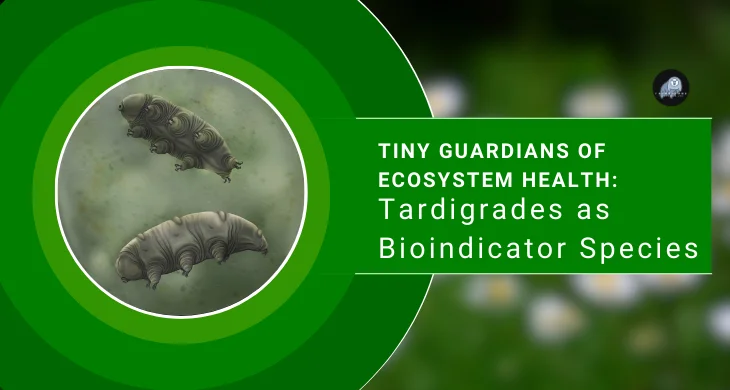In the intricate tapestry of our natural world, there exist tiny, enigmatic creatures known as tardigrades. These minuscule organisms, often affectionately referred to as “water bears” or “moss piglets,” play a role far more significant than their size suggests. They are the unsung heroes of ecological health, serving as bioindicator species that silently monitor the well-being of our ecosystems. In this exploration, we delve into the fascinating realm of tardigrades and unveil their crucial role as sentinels of environmental balance.
The Extraordinary World of Tardigrades:
Enter the fascinating realm of tardigrades, those extraordinary microorganisms that defy expectations at every turn. In this section, we embark on a journey to discover the remarkable features that make tardigrades truly exceptional.
Meet the Tardigrades: Tardigrades, often affectionately referred to as “water bears” or “moss piglets,” are microscopic animals that capture the imagination with their minuscule yet intricate existence. Despite their size, they are a force to be reckoned with in the world of biology.
The Resilience of Water Bears: Tardigrades have earned their reputation as resilient survivors. They are found in diverse habitats across the globe, from the depths of the ocean to the peaks of the highest mountains. What sets them apart is their uncanny ability to endure extreme conditions that would prove fatal to most other organisms.
Surviving the Unthinkable: Imagine a creature that can withstand desiccation, where it dries up to a lifeless-looking state only to spring back to life when rehydrated. Picture an animal that laughs in the face of extreme temperatures, radiation, and even the vacuum of space. These are the feats that tardigrades routinely accomplish, captivating scientists and nature enthusiasts alike.
Tardigrades as Bioindicator Species:
We unravel the significant role that tardigrades, those microscopic marvels, play as bioindicator species. They are the unspoken guardians of our ecosystems, providing invaluable insights into the health and well-being of our natural world.
Defining Bioindicators: Bioindicator species are nature’s early warning systems, revealing the condition of their environment through their presence, behavior, and population dynamics. They act as sensitive barometers, attuned to even subtle environmental shifts.
Tardigrades’ Ecological Significance: Tardigrades emerge as particularly crucial bioindicators due to their sensitivity to environmental changes. These resilient creatures, despite their size, are finely tuned to their surroundings. Their very presence or absence can convey vital information about the conditions of an ecosystem.
Adaptable and Responsive: Tardigrades are highly adaptable organisms, capable of swift responses to alterations in their environment. When faced with changes, they serve as early detectors, sounding alarms about potential disturbances or shifts in ecological balance.
Reflecting Biodiversity: The diversity of tardigrade species within a given ecosystem mirrors the overall biodiversity of that environment. A thriving community of tardigrades indicates a healthy and diverse habitat. Conversely, a decline in tardigrade diversity may signal broader ecological imbalances that warrant attention.
Monitoring Environmental Changes:
We delve into the essential role played by tardigrades as environmental monitors, adeptly detecting and responding to changes in their surroundings. These tiny creatures serve as nature’s early-warning system, providing valuable insights into shifts within ecosystems.
Adaptable and Responsive: Tardigrades’ adaptability is matched by their responsiveness to alterations in their environment. Whether it’s fluctuations in temperature, moisture levels, or other ecological factors, tardigrades swiftly adjust to these changes. This adaptability allows them to serve as early detectors, raising alarms about potential disturbances.
Signs of Environmental Shifts: Changes in tardigrade populations or behaviors can be indicative of broader environmental shifts. A decline in their numbers, for example, may suggest the introduction of pollutants or habitat degradation, while an increase could signal improved conditions or habitat restoration efforts.
Ecosystem Health Barometers: Tardigrades, with their sensitivity and rapid responses, act as barometers of ecosystem health. Researchers and conservationists often study their populations and diversity to assess the overall well-being of an ecosystem. By focusing on these tiny organisms, we gain a clearer picture of the broader ecological dynamics at play.
Early Warning Systems: Just as canaries were once used to detect toxic gases in coal mines, tardigrades serve as early warning systems in natural environments. Their presence or absence can offer critical insights into the quality and stability of ecosystems, helping us identify areas in need of conservation or restoration efforts.
Conservation and Biodiversity Preservation:
We turn our attention to the critical imperative of conserving biodiversity and preserving the delicate balance of ecosystems, with a focus on the pivotal role that tardigrades play in this ongoing endeavor.
Conservation Imperative: The study of tardigrades as bioindicator species brings to the forefront the vital importance of conserving biodiversity. It is not merely a matter of scientific curiosity but a moral and ecological imperative. We are tasked with the responsibility of ensuring the protection of unique species and their habitats for generations to come.
Ecosystem Health and Human Well-being: Healthy ecosystems are not just a concern for environmentalists; they are a necessity for human survival and well-being. Ecosystems provide us with clean air, fresh water, fertile soil, and countless other services that sustain our lives. Understanding and preserving biodiversity is essential for maintaining these services.
The Fragility of Ecosystems: Tardigrades serve as sentinels in ecosystems that can be remarkably fragile. The introduction of disturbances, whether from human activities, climate change, or other factors, can have far-reaching consequences. Recognizing tardigrades’ role in these ecosystems underscores the need for responsible environmental stewardship.
Global Impact: The conservation of biodiversity in one region can have far-reaching global impacts. Ecosystems are interconnected, and changes in one area can trigger ripple effects across the planet. Preserving biodiversity in the Himalayas, for example, can influence climate patterns, support freshwater sources, and contribute to the maintenance of genetic diversity on a global scale.
Education and Awareness: The study of tardigrades as bioindicators serves as an educational tool, raising awareness about the importance of biodiversity conservation. It reminds us that even the tiniest creatures have a vital role to play in the grand tapestry of life.
FAQS:
Q1. What are bioindicator species, and why are they important?
Ans: Bioindicator species are organisms that provide insights into the health of their environment. They are essential because they can detect environmental changes early, helping us monitor ecosystem health.
Q2. How do tardigrades serve as bioindicator species?
Ans: Tardigrades are sensitive to environmental changes and can quickly respond to alterations in their surroundings. Their presence or absence can indicate shifts in an ecosystem’s condition.
Q3. Can tardigrades indicate specific environmental issues?
Ans: Yes, tardigrades can provide clues about various environmental issues, such as pollution, habitat degradation, or habitat restoration. Changes in their populations or diversity can point to specific problems.
Q4. Are tardigrades only found in specific ecosystems, or are they widespread?
Ans: Tardigrades are found in a wide range of ecosystems, from marine environments to terrestrial habitats.
Q5. How can we use information about tardigrades for conservation efforts?
Ans: Studying tardigrades can help conservationists assess the overall health of ecosystems. Their presence can indicate the success of conservation and restoration efforts or identify areas in need of attention.
Q6. Are tardigrades endangered or threatened by environmental changes?
Ans: While tardigrades are resilient, they can still be affected by severe environmental disturbances. Understanding their presence and diversity can help monitor potential threats to their populations.
Conclusion:
In the intricate web of life that blankets our planet, even the tiniest of creatures can bear the weight of profound responsibility. Tardigrades, those microscopic marvels, stand as exemplars of this truth, silently guarding the health of our ecosystems as bioindicator species. As we conclude our exploration of their remarkable role, we are left with a profound appreciation for the interconnectedness of all life forms on Earth.
Tardigrades, those adaptable and resilient beings, provide us with insights into the ever-changing tapestry of our natural world. Their sensitivity to environmental shifts, whether subtle or severe, offers us early glimpses into the health and balance of ecosystems. Their presence or absence can signify the success or challenges of our conservation efforts, shining a light on areas that require our attention and care.
Yet, the story of tardigrades is not just about their contributions to science or conservation; it is also a reminder of our shared responsibility as stewards of the Earth. It beckons us to embrace the role of protectors and advocates for the biodiversity that sustains us all. Their silent vigil serves as a poignant call to action, urging us to preserve the delicate balance of our ecosystems, not only for their sake but for the sake of future generations.
In the quiet resilience of tardigrades, we find a powerful testament to the resilience of life itself. Their story is one of unity, resilience, and the enduring power of nature. As we move forward, may we carry the lessons of these tiny guardians in our hearts, advocating for the protection and nurturing of the delicate balance of our ecosystems

